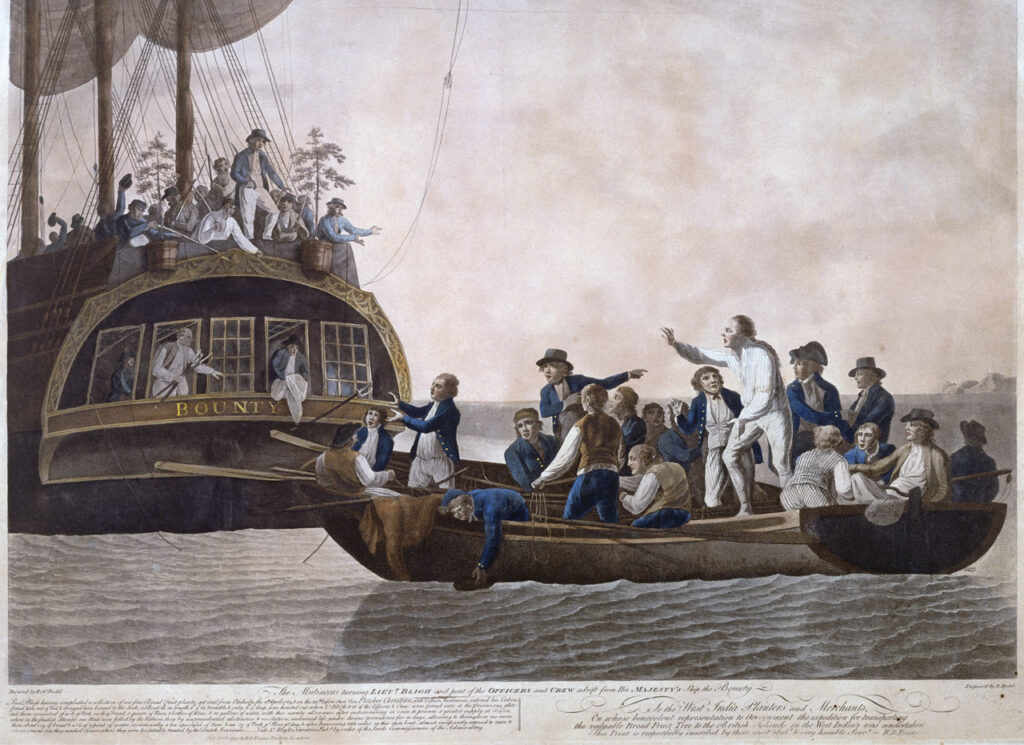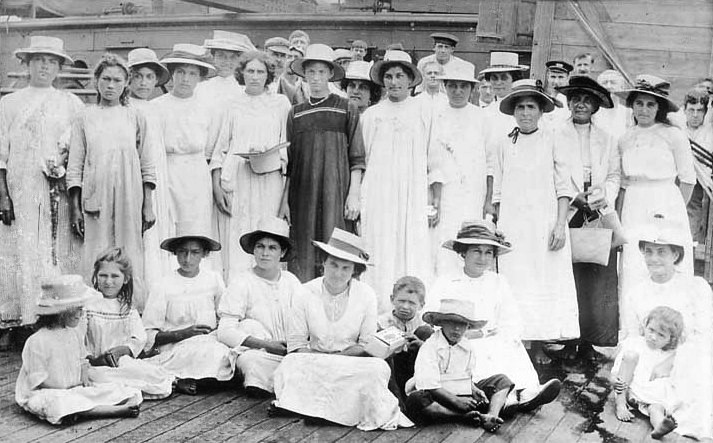The mutiny of the HMS Bounty on April 28, 1789, is unrivaled in the annals of rebellions in Naval history.
Brought to mainstream awareness, primarily by three highly-successful major motion pictures (in ’35, ’62, and ’84) based on the Charles Nordhoff and James Hall historical novel Mutiny on the Bounty, these films focus primarily on the events that triggered the mutiny and the mutineers’ subsequent efforts to elude punishment.
However, the scandalous history of Pitcairn Island, the mutineers’ unintended final destination, is more fascinating. The place where the violations they perpetrated at sea pale compared to the scandalous transgressions they’ve since perpetrated on land.

The Ambitious Mission
The HMS Bounty was a three-masted, 91 feet long by 25 feet-wide armed vessel of the “cutter” class and technically a Royal British Navy warship.
Commissioned at the urging of Sir Joseph Banks, president of the Royal Society, the Bounty was charged with collecting and transporting breadfruit plants from the South Pacific island of Tahiti to the British colonies of the West Indies.
Banks championed the view held by many Caribbean plantation owners that breadfruit might flourish in the West Indies and be a cheap food source for the growing slave population.
Command of this ambitious mission was given to Lieutenant William Bligh, with Sailing Master John Fryer, Master’s Mate Christian Fletcher, and several other warrant officers filling the ranks–either hand-picked by Bligh himself or appointed by the Navy Board.
To successfully achieve the grand design of the expedition, the Bounty was refitted to accommodate over 1000 potted breadfruit plants–which meant Bligh and his crew of 46 men (which included two botanists) would be subjected to severe overcrowding for the duration of the voyage, which would ultimately involve circumnavigating the globe.
In December of 1787, the Bounty departed England for Tahiti and arrived ten months later, in October of 1788. During these 10 months, tensions between Bligh and his crew, who considered him an oppressive and insulting commander, had become intolerable.
The relationship between Bligh and Master’s Mate Christian Fletcher was particularly strained. During the five months it took to collect, pot, and secure the breadfruit saplings for the return voyage, the crew became so adapted to Tahitian life that many decided to abandon the mission and remain there (Fletcher Christian himself had taken a Tahitian wife).
As the departure date neared, three crew members chose to desert rather than leave the idyllic life they’d come to love.
The Mutiny
On April 4, 1789, the Bounty departed Tahiti for the West Indies, forcing many crewmen to leave the life of peace and tranquility they much preferred over what they faced on the open sea with Bligh.
Within a few days, Bligh’s abuse of the crew again reached intolerable levels, accusing some of them of stealing coconuts from the ship’s store and threatening severe punishment.
While there is no documented accounting of the coconuts on the Bounty, it is known that they were commonly kept on board for long sea voyages as a source of potable water, high-calorie food, fiber that can be fashioned into rope, and shells that can be turned into charcoal. Additionally, coconuts can be used to construct a flotation device in an emergency.
Fletcher Christian, growing increasingly unnerved by the abusive treatment he and the crew were receiving, reached the point where he could not seize control of the ship.
On April 28, Christian and several members of the disgruntled crew relieved Bligh of command and then forced him and eighteen men loyal to him into a 23-foot boat built to accommodate 12, setting them adrift on the open sea.
Christian immediately altered course in search of an uninhabited island where he and his fellow mutineers could take refuge. Finding none, he returned to Tahiti, where he dropped off those who wished to remain on the island, then recruited twelve female and six male islanders (and reportedly one child) to man the Bounty.
Loading whatever provisions were available, he then resumed his search for an island where he and his crew could hide from the authorities he knew would invariably pursue.
In January of 1790, the Bounty settled on Pitcairn Island, an isolated, uninhabited volcanic rock a little more than 1000 miles east of Tahiti.
Meanwhile, the mutineers he delivered to Tahiti were captured and taken back to England, where three were hanged for mutiny. The British ship searched for Christian, and the others never found them.
Pitcairn Island: Desperate Times, Desperate Measure
Despite the crew’s best efforts to ensure their survival, the Bounty mutineers and their Tahitian collaborators were never far from oblivion.
While initially, each mutineer had a wife (three women were shared by the six Tahitian men, apparently within their custom), equanimity on the island was destroyed when one mutineer’s wife died, prompting him to poach the wife of two Tahitian men.
This unforgivable betrayal set off a wave of widespread upheaval that continued for more than ten years and left only three men alive, Fletcher Christian among those murdered.
By the time an American whaling ship happened by this outlying island in 1808, only one man, John Adams, remained alive (along with an unknown number of women and children), and the unconventional mating habits the Bounty men had instituted to perpetuate survival were already in full swing.
Habits proved relatively successful for over two centuries. But then the present collided with their past in a most unforeseeable way.
Public Scandal and Long Arm of the Law
In 1999 a female island resident mentioned in passing Pitcairn’s long-standing mating practices to a visiting British policewoman.
This ignited an in-depth international inquiry seeking to depose every living Pitcairn female residing on and off the island (per British law). This investigation led to many years of accusations, revelations, issues of legal jurisdiction—and, of course, an eye-opening education in Pitcairn Island history.
During the preliminary inquiry, it was discovered that Pitcairn Island’s population peaked in 1937 when it approached 250. But since that time, even with what the public viewed as “scandalous” mating habits, the relatively-isolated occupants of the island had struggled to maintain a sustainable population.

In September of 2004, a panel of 20 judges, lawyers, and full court staff effectively invaded Pitcairn Island, intent on bringing the accused to justice. It should be noted that while several of the women said they would like the mating practices to stop, none filed formal charges nor demanded it.
Seven Pitcairn men (about half the male population) were formally changed with fifty-five counts of rape, indecent assault, and sexual abuse of girls as young as five years of age, stemming from changes dating back to 1964. Several women were also investigated as accomplices or facilitators but never charged.
Eight accusers, whose testimonies were transmitted via video conference to the makeshift courtroom from New Zealand, where most of them then resided, described Pitcairn as a society where men do pretty much whatever they want, with abuse and rape as the normal way of life.
But while several Pitcairn women confirmed girls’ initiation into sexual relationships by age 12, a number of them said these relationships are purely consensual—not forced–and are considered normal on Pitcairn.
Most acknowledged that without their unusual mating habits, Pitcairn would have ceased to exist long ago.
Defense for the Pitcairn accused argued that British authority does not apply to the descendants of the Bounty mutineers because they de facto renounced British citizenship when they staged the mutiny and then founded the colony.
And beyond the moral and legal implications these proceedings entail, most families have a defendant, an accuser, or both involved–making objectivity impossible.
During the trial, it was pointed out that Pitcairn men are not simply essential to the population; they are vital to the colony’s day-to-day survival: from manning the longboats transporting supplies from passing ships to holding indispensable positions as firemen, postmaster, dentist, and minister.
All those involved in the proceedings came to realize that condemning any of these men to anything more than symbolic punishment would be tantamount to punishing the entire population of Pitcairn and effectively destroying the cultural heritage they’ve struggled for generations to perpetuate.
Adjudication
In October of 2004, six of the seven charged were found guilty of a variety of sexual assault offenses–from simple assault to rape:
Steve Christian, a 50-year-old descendant of Fletcher Christian, and his son Randy, were found guilty of 14 counts of rape and indecent assault. Steve was sentenced to three years in Pitcairn Prison (but has yet to serve); Randy to six years.
Another Christian heir, Dennis Christian, postmaster, was convicted of one charge of indecent assault and two sexual assaults and sentenced to 300 hours of community service.
Len Brown (father-in-law of Steve Christian) was sentenced to two years of home detention; Len’s son, Dave, 400 hours’ community service.
Lastly, Carlyle Young, a descendant of Bounty midshipman Ned Youn, was sentenced to five years in Pitcairn Prison.
In 2007, two more defendants were found guilty of rape and indecent assault charges: Shawn Christian (another Christian descendant) and Brian Young (Ned Young descendant) were sentenced to three and a half years and six and a half years, respectively.
After serving two years of his sentence, Christian was released from prison and subsequently elected Mayor of Pitcairn, while Young’s sentence was reduced to house arrest after serving two years.
The current residents of Pitcairn Island (47 in number as of April 2021), come from four specific families, two of which descend from the original Bounty crew: the Christians and Warrens (Bounty members), the Youngs and Browns who were descendants of two sailors who subsequently shipwrecked there in the 1800s.
Despite severe scrutiny and world condemnation, life on Pitcairn Island goes as it always has. A daily struggle to survive that they all seem more than willing to face.
References/Resources
Pitcairn Government website: http://pitcairn.pn/
History.com: https://www.history.com/this-day-in-history/mutiny-on-the-hms-bounty
The Guardian, “Judges Arrive on Pitcairn as Abuse Trials Loom,” https://www.theguardian.com/world/2004/sep/25/davidfickling
The Guardian, “Six Found Guilty in Pitcairn Sex Offenses Trial,” https://www.theguardian.com/world/2004/oct/26/davidfickling
Coconuts at Sea: https://source.wustl.edu/2011/06/deep-history-of-coconuts-decoded/

